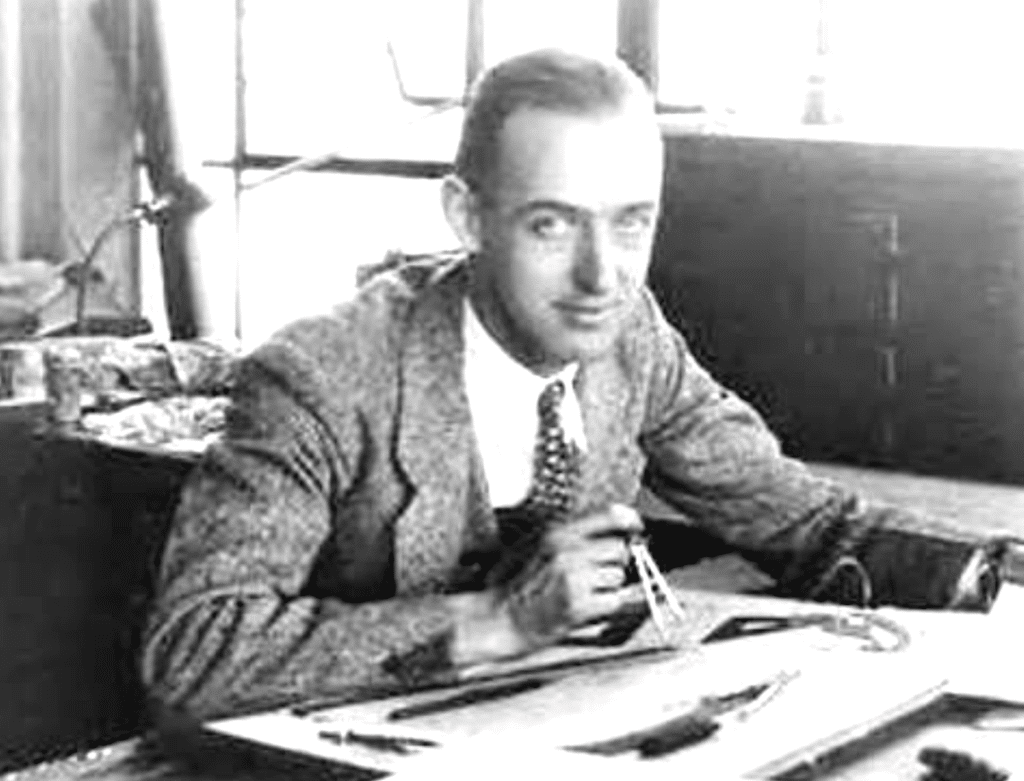
It must have come as a surprise when, this week in 1936, dealers got to see the new Cord 810, the first Cord since the 1932 Cord L-29 ended production. In the interim, Cord Corp. sold the lower-priced Auburn, built in Auburn, Indiana, and the stratospherically-expensive Duesenberg, built in Indianapolis.
But now, the Cord had returned, and like the L-29, the 810 was front-wheel drive. But the 810’s design was a knockout, the handiwork of Cord Corp. designer Gordon Buehrig, then a mere 32 years old.
But the stunning new automobile had first started development back in 1933, and it wasn’t meant to be a Cord.
A design born at General Motors
It’s early in 1933, and Gordon Buehrig doubted Duesenberg Motors’ continued viability in the depths of the Great Depression. So Buehrig decamps to General Motors.

Once there, GMs first design chief Harley Earle holds a contest among five design teams to design a four-door sedan to be shown at the Chicago Century of Progress exhibition. One of the teams was led by Buehrig, and involved Buehrig’s idea of using of two radiators that would block air to the engine, thus keeping the compartment clean. “It wasn’t a very good idea,” he wrote in his memoir, “Rolling Sculpture.” “But it set up a package problem that was bound to give a new look to the front end.”
While his team was happy with the result, Buehrig’s design placed last.
Then in September 1933, Buehrig receives a call from Cord Corporation president Harold Ames to discuss the idea of a smaller, lower-price Duesenberg to supplement the company’s costly, custom-bodied Model J. The idea was hardly a new one; Cadillac had launched its lower-priced LaSalle in 1927, underpinned by an Oldsmobile chassis. Ames was looking for something similar, employing the machinery used to manufacture Auburns. The meeting with Ames leads Buehrig’s resignation from GM, taking his failed design with him.
Once more at Duesenberg, Buehrig revives his GM two-radiator sedan. Ames didn’t think buyers would care about a clean engine compartment, but he was intrigued by the notion of a car without a traditional front-mounted radiator.
“I made two pencil sketches for him and he approved the idea,” Buehrig recalls. “The body was built by Weymann in Indianapolis and Derham followed the details of its construction. While this was going on, Auggie Duesenberg was reworking an Auburn chassis and the problems of the twin radiator arrangement.”
Buehrig said the resulting car should have gone into production in February 1934. But a corporate crisis would delay its launch.
A corporate crisis brings success

When Harold Ames arrived in 1933 to serve as president of Cord Corporation, he discovered a 1934 Auburn that had been redesigned to the chagrin of Auburn’s dealers. Ames wasn’t any happier, and he assigns Buehrig and Auggie Duesenberg the task of a crash redesign of the car.
“With a $50,000 budget, we couldn’t do much,” Buehrig recalls.
He changes the fenders’ design, enlarges the radiator shell and grille, and gives the hood a fresh appearance. Meanwhile, Duesenberg works with the Lycoming Engine Division, developing a supercharged straight 8.

Dubbed the Model 850, sales pick up. But its June introduction proves problematic.
“It didn’t give us a new ‘bomb’ for show time when the other automobile companies were making their normal 1935 model line announcements. Ames wanted a sensational model to gain the free coverage of the media which you can only get at auto show time if you have something worthy of their attention.”
Having design boattail speedsters for Duesenberg, Buehrig decides to do the same for Auburn. Ready for the 1935 auto show season, the model brought the attention Ames had wanted. “It stole the show and much of the newsprint,” Buehrig said.
A stillborn project revived

With Auburn’s fortunes steadied, attention turns once again to the baby Duesenberg.
“A decision was made, presumably in Cord Corp.’s Chicago headquarters, to revive the small Duesenberg program but do it in Auburn, to redesign it for a V-8 and front-wheel-drive configuration and call it a Cord.”
If the Cord’s exterior design was extraordinary, so was the interior’s innovations. Buehrig designed the instrument panel to house different size gauges so that drivers could tell them apart at a glance. Among them, was a tachometer, unusual for the time. The Cord was also the first car that allowed the driver to adjust the level of instrument panel lighting.

Its 4.7-liter V-8 engine powered the front wheels through a Bendix Electric Hand 4-speed manual gearbox. The driver shifted from first into second gear by moving a thumb lever mounted in an h-gate at the end of a column-mounted stalk. The vacuum-powered clutch servo engaged once the driver either depressed and released the clutch pedal or lifted their foot off the throttle and reapplied it.
But perhaps the Cord’s biggest innovation are its pop-up headlights. Originally designed to be electrically operated, development costs proved too high. So, they are manually cranked open and closed. Then there was its radio antenna; it’s located under the car so it wouldn’t clutter the car’s design.
The Cord 810 would be revealed to dealers this week in 1935, followed by its public showing at the New York Auto Show on November 2nd.
“To say the Cord stole the show would be an understatement,” Buehrig said. “Optimism was high.”

But the car’s launch didn’t go well. The company attempted to build 1,000 units monthly, a scale the automaker never before attempted.
“Production of the Cord got underway lowly and the first cars were plagued with trouble. The cars overheated in warm summer weather and the transmissions didn’t work well. … It is surprising the car lasted two years.”
But by the time the problems were resolved, Cord Corp. was finished.
Surprisingly, the Cord 810 was not.
One more chance

Hupp Motor Car Co. of Detroit was seeing its own fortunes decline in 1937, and saw the Cord 810’s popularity as a lifeline. So they bought its tooling and dies for use as a new model, the Hupp Skylark.
But Hupp made changes, tapering its classic coffin-nose hood and adding a three-piece radiator. Fixed headlights replaced the pop-up units. And Hupp’s own rear-wheel-drive powertrain powered by an inline six supplanted the Cord’s V-8 and front-wheel drive.
Even worse, another bastardized version of the car was offered by Graham-Paige Motors, which had also fallen on hard times. Their version, the Graham Hollywood, fared little better than the Hupp Skylark. By 1940, both models were gone.
- SEO Powered Content & PR Distribution. Get Amplified Today.
- PlatoData.Network Vertical Generative Ai. Empower Yourself. Access Here.
- PlatoAiStream. Web3 Intelligence. Knowledge Amplified. Access Here.
- PlatoESG. Carbon, CleanTech, Energy, Environment, Solar, Waste Management. Access Here.
- PlatoHealth. Biotech and Clinical Trials Intelligence. Access Here.
- Source: https://www.thedetroitbureau.com/2023/09/the-rearview-mirror-birth-of-a-legendary-design/
- :is
- :not
- $UP
- 000
- 1
- 1933
- 1934
- 32
- 8
- a
- About
- adding
- adjust
- again
- AIR
- allowed
- also
- among
- an
- and
- Announcements
- Another
- antenna
- any
- apart
- approved
- ARE
- arrangement
- arrived
- AS
- At
- attempted
- attention
- auto
- automobile
- Baby
- back
- BE
- been
- before
- Better
- Biggest
- birth
- Block
- body
- born
- both
- bought
- bound
- Brings
- brought
- budget
- build
- built
- Bureau
- but
- buyers
- by
- Cadillac
- call
- CAN
- car
- care
- cars
- Century
- Changes
- chassis
- chicago
- chief
- classic
- closed
- clutter
- CO
- come
- Companies
- company
- Company’s
- concept
- Configuration
- construction
- contest
- continued
- Corp
- Corporate
- CORPORATION
- costly
- Costs
- could
- coverage
- Crash
- credit
- crisis
- decision
- Decline
- delay
- depression
- Depths
- Design
- designed
- Designer
- details
- developing
- Development
- different
- discovered
- discuss
- Division
- do
- Drawings
- drive
- driver
- drivers
- Early
- either
- Electric
- end
- ended
- engaged
- Engine
- equally
- exhibition
- extraordinary
- Failed
- Fallen
- February
- filled
- First
- five
- fixed
- followed
- Foot
- For
- fortunes
- Free
- fresh
- from
- front
- Front end
- Gain
- Gear
- General
- General Motors
- get
- Give
- gives
- Glance
- GM
- GMS
- Go
- going
- gone
- good
- gordon
- got
- graham
- great
- Great Depression
- had
- hand
- happier
- happy
- Hard
- harold
- Have
- he
- Headquarters
- High
- him
- his
- holds
- Hollywood
- hood
- House
- HTTPS
- idea
- if
- in
- Indiana
- Innovation
- innovations
- instrument
- interim
- interior
- into
- Introduction
- involved
- IT
- ITS
- jpg
- june
- keeping
- Last
- launch
- launched
- Leads
- Led
- left
- legendary
- Level
- Lifted
- Lighting
- like
- Line
- little
- located
- Look
- looking
- machinery
- made
- Making
- manual
- manually
- max-width
- meant
- Meanwhile
- Media
- meeting
- mere
- mirror
- model
- models
- monthly
- more
- Motor
- Motors
- moving
- much
- must
- never
- New
- New York
- normal
- Notion
- November
- now
- of
- off
- offered
- Old
- on
- once
- ONE
- only
- open
- operated
- or
- originally
- Other
- own
- package
- panel
- patent
- perhaps
- photo
- pick
- plagued
- plato
- Plato Data Intelligence
- PlatoData
- pop-up
- popularity
- powered
- president
- Problem
- problems
- Production
- Program
- Progress
- project
- proved
- proves
- public
- Radio
- ready
- receives
- redesign
- redesigned
- released
- replaced
- Resignation
- resolved
- result
- resulting
- Revealed
- Revive
- Said
- sales
- same
- saw
- say
- Scale
- Season
- Second
- see
- seeing
- September
- serve
- set
- Shell
- shifted
- should
- show
- showing
- shown
- similar
- since
- SIX
- Size
- small
- smaller
- So
- sold
- something
- started
- stole
- straight
- Stunning
- summer
- supplement
- surprise
- surprising
- taking
- Task
- team
- teams
- tell
- than
- that
- The
- their
- Them
- then
- There.
- they
- think
- this
- this week
- Through
- Thus
- time
- times
- to
- too
- traditional
- trouble
- turns
- twin
- two
- under
- underpinned
- Underway
- units
- unusual
- us
- use
- used
- using
- version
- very
- viability
- View
- wanted
- warm
- was
- we
- Weather
- week
- WELL
- were
- when
- which
- while
- with
- without
- Work
- works
- worse
- would
- wrote
- years
- york
- you
- zephyrnet













